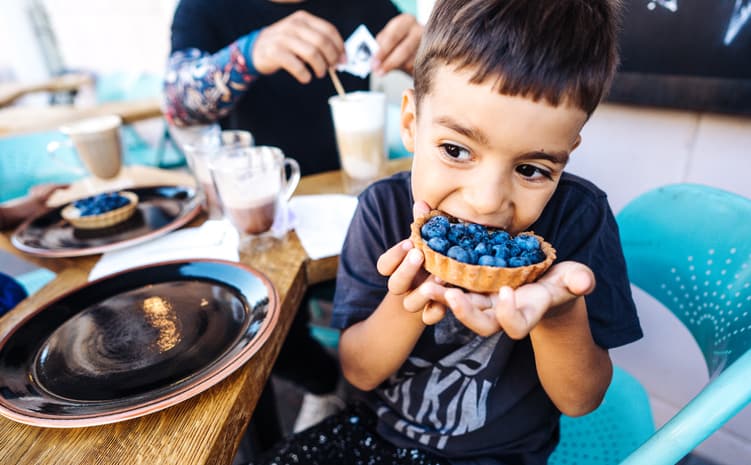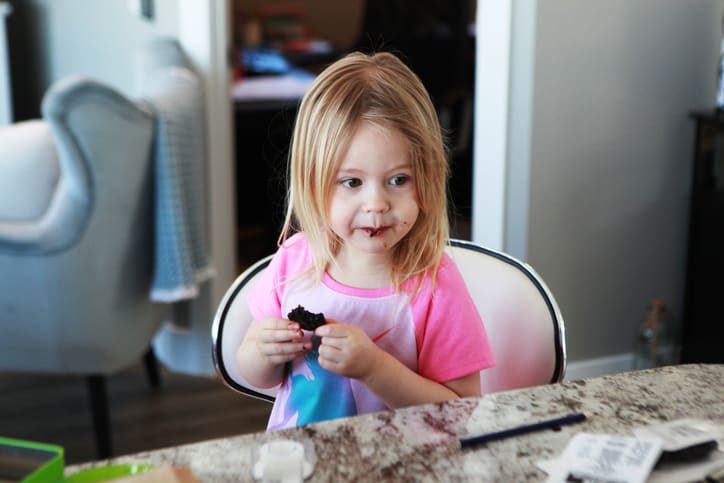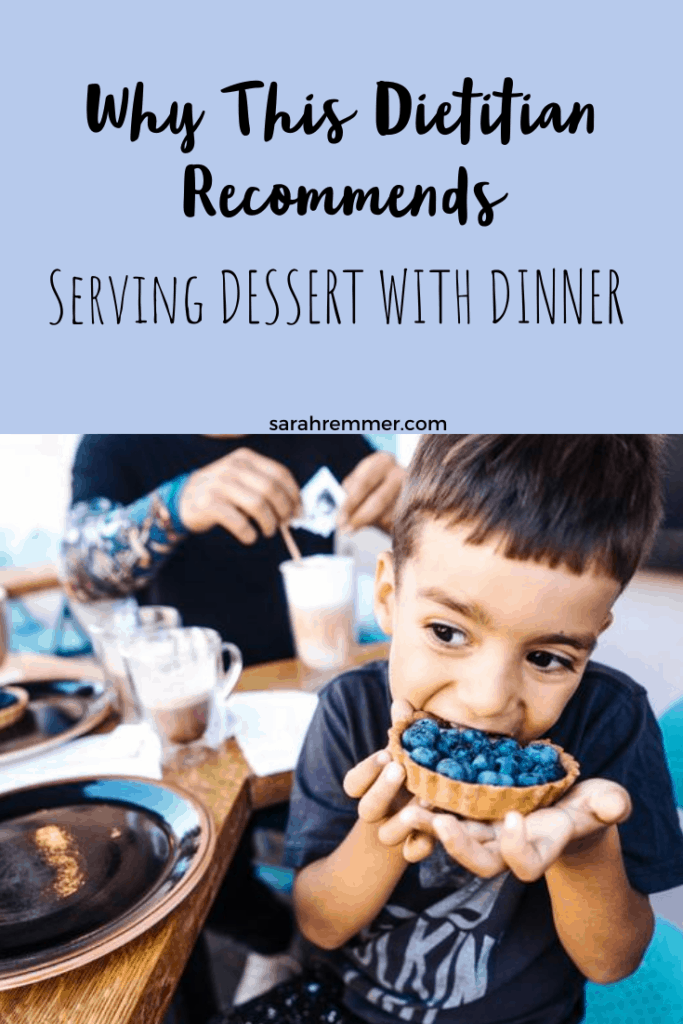Here are 5 reasons why you should consider serving dessert with dinner (and how to go about doing it!)
Do you ever notice that your kids race through their meal (or find excuses not to eat it) only to get to the prize at the end: dessert? Are they hyper-focused on if dessert will be served and what it is? Or are the constantly asking for treats throughout the day? Are you concerned that your child is becoming a sugar monster? If you answered yes to any of these, you may want to consider serving dessert WITH dinner once in a while.
Wait. What?! With dinner? Won’t my kids just eat dessert and not touch their other foods?!
Maybe. And maybe not. Either way, it doesn’t really matter. Whether they gobble up their dessert foods only or nibble on all foods equally, this strategy helps kids to have a healthier relationship with food long term. If you’re able to do this regularly (let’s say once a week), you’ll notice over time that your child will become relaxed about the dessert foods and start to put all foods on a level playing field. Serving dessert with dinner neutralizes foods – nutritious or not. All of a sudden, dessert isn’t the reward, only to be earned after eating those other “healthy” (yucky) foods. You might notice less requests for treats, less fixation on dessert foods, less picky eating habits and happier mealtimes overall. Not convinced? Stay with me here…
5 reasons why serving dessert with dinner works so well:
1) Dessert is no longer a “reward”
When dessert is served after dinner regularly, kids tend to see it as a prize or reward. They may think, “mom made me eat those gross vegetables, but I get rewarded with pudding after, so it’s worth it!” It also sends the message that kids need to eat a certain amount of food to be considered “good” and deserving of that reward. In some cases, it leads to children who won’t ever eat vegetables unless there is a cookie waiting for them afterwards (in other words… a reward junkie). Instead, we want to separate foods from any reward or punishment strategy, and neutralize them. Food is food, not a prize, nor a punishment. When dessert is served with dinner, it’s just another option that they can put on their plate if they want to.
2) Your child is more likely to fill up on nutritious foods
When dessert is the end-goal, kids get so excited to get to it, which means they rush through dinner. The result? They don’t pay attention to their hunger or fullness cues. Picture this: Your child eats a quick dinner so they can have dessert, and an hour later they are still hungry. That’s because they didn’t eat enough of the meal (think protein, fibre, dietary fat) to satisfy their appetite! Or maybe they didn’t eat much at dinner because they wanted to save room for dessert. In either case, once dessert becomes part of the meal, kids can eat slowly and calmly, and will have more time to focus on their tummy and know if it’s hungry or full.
If your child tends to rush through dinner often, you might want to consider setting a timer for at least 10-15 minutes of simply sitting at the table for family time (without the pressure to eat). This might prompt your child to eat more mindfully and take their time. My favourite dinner table timers are these colourful sand timers.
3) Your child is more likely to stop when they’re full
Or, the opposite can happen: If dessert is served last and your child is already full from dinner, they may eat dessert anyway because it’s so tempting. Holding dessert until the end teaches kids to keep eating until they are full, and then eat some more. This message doesn’t help them learn self-regulation. Our goal is to teach kids to moderate their own food intake, and stop eating when they feel satisfied. It’s easier to do that when the entire dinner – including dessert – is served at the same time.
4) There will be less questions about/ requests for dessert or treats overall
Do you notice that your kids are already asking you “what’s for dessert?” before they even take a bite of their meal? If this drives you crazy, end the suspense by having dessert on the dinner table in the first place. When kids have the choice to eat it before, during or after the meal, it gives them a sense of control and makes them feel responsible and trusted.
5) The allure of treats is taken down a HUGE notch
You’ll start noticing that your kids ask about treats less often. Your kids may become more neutral and relaxed when treats are around or offered–let’s say at a birthday party or at Christmas time. They may become more picky and choosy with what they indulge in and even turn down offers for treats (can you imagine?!), whereas before they may have jumped at any chance to eat them whenever possible. See, a food is available to them or offered regularly (and not used as a reward), they don’t feel deprived of it or they don’t hold the same allure, so they crave them less–they’re taken off their pedestal. If kids know that they’ll get the chance to have dessert regularly, they’re more likely to be mindful with them.
A few things to consider
Do it randomly
Serving dessert randomly with dinner does not mean serving dessert every night. The frequency is a personal choice, but my recommendation is to do this randomly but regularly – let’s say once a week. Perhaps you offer dessert alongside dinner once and then maybe there’s a dessert offered after lunch one day, and then maybe there’s a treat offered with a snack one day. The more random the better, so that your kids know that there will be plenty of opportunities, but it doesn’t become an expectation at a certain time during the day.
Be mindful of portions
Kids’ tummies are small, so we want to ensure that we’re reserving most of that space for nutritious foods. The portion sizes should be small and manageable. I’m talking 50-100 calories of fruit, sweetened yogurt, pudding, cookies or ice cream, not a 500-calorie ice cream sundae with whip cream on top. I also recommend offering only one small portion (not endless amounts) of dessert when you serve it alongside a meal. A small sweet treat will not diminish your child’s appetite for the other foods being served, and will help them learn important mealtime concepts like balance and moderation. Sugar is out there, people. Instead of ignoring it, let’s teach our kids how to eat it in a balanced way.
The novelty will wear off – I promise
Can you picture the look on your child’s face when they see a chocolate chip cookie alongside the salmon and baby potatoes? They will be excited and will likely eat the cookie first. But after a few occurrences, the novelty will wear off. You’ll find that some days they will choose dessert first, some days last, and some days they won’t even finish it. That’s when they’ve learned to normalize dessert as just another food, rather than an event.
This post may contain affiliate links. View our policy.
source https://betterweightloss.info/why-this-dietitian-recommends-serving-dessert-with-dinner/






No comments:
Post a Comment